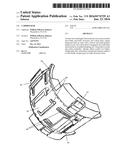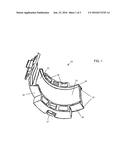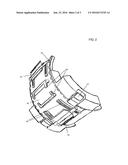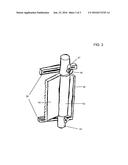Patent application title: Carrier Base
Inventors:
IPC8 Class: AA47D1302FI
USPC Class:
2971836
Class name: Chairs and seats with handle for nonoccupant use
Publication date: 2016-06-23
Patent application number: 20160174729
Abstract:
An innovative and highly functional new twist on an essential and widely
used baby accessory, the Carrier Base, unique design provides its users
with a diverse and multi-purpose infant car seat. The Carrier Base is
designed to fit comfortably and securely in a standard shopping cart. The
product is easily and safely reclinable, offering added comfort for
babies. Additionally, the Carrier Base's proprietary features enable it
to offer handy storage space for other necessary items.Claims:
1. A carrier base comprising: a base for pivotably supporting a carrier,
the base comprising a bracket side forming a plurality of positioning
notches and a plurality of channels; a carrier comprising a carrier
surface coupled to a plurality of release member and a base surface
having base sidewalls forming elongated slots for pivotably receiving the
base, wherein a user can adjust the carrier relative to the base by
disengaging and then engaging the plurality of release members into the
positioning notches; and a plurality of interlocking brackets rotatably
mounted to the base, the interlocking brackets comprising a interlocking
surface, a handle and a plurality of channel pins coupled to a support
bar, wherein the interlocking surface releasably attaches to a host
apparatus so that the user can rotate the base relative to the host
apparatus by urging at least one handle so that the channel pins move
within the base channels.Description:
BACKGROUND OF THE INVENTION
[0001] The present invention relates to child restraints and, more particularly, to a base configured to rotate and adjust the position of an infant carrier. Currently, safety seats and infant carriers are in wide use. Unfortunately, known infant carriers and their bases, are unable to accommodate varying inclination while attached to host apparatus so that the carrier adjusts relative to the base and the base adjusts relative to the host apparatus.
[0002] As can be seen, there is a need for a base that supports an infant carriers that accommodates various inclinations while attached to host apparatus so that the carrier adjusts relative to the base and the base adjusts relative to the host apparatus.
BRIEF DESCRIPTION OF THE DRAWINGS
[0003] FIG. 1 is a perspective view of an exemplary embodiment of the present invention;
[0004] FIG. 2 is a perspective bottom view of an exemplary embodiment of the present invention; and
[0005] FIG. 3 is a detailed view of an exemplary embodiment of the interlocking bracket of the present invention.
DETAILED DESCRIPTION OF THE INVENTION
[0006] The following detailed description is of the best currently contemplated modes of carrying out exemplary embodiments of the invention. The description is not to be taken in a limiting sense, but is made merely for the purpose of illustrating the general principles of the invention, since the scope of the invention is best defined by the appended claims.
[0007] Broadly, an embodiment of the present invention provides a carrier base. The carrier base may include a carrier pivotably coupled to a base. The base may be rotatably mounted a plurality of interlocking bracket. The interlocking brackets may be releasably attach to a host apparatus so that the base may be pivotably adjusted relative to the host apparatus.
[0008] Referring now to FIGS. 1 through 3, the present invention may include a carrier base 10. The carrier base 10 may include a carrier 20, a base 30 and a plurality of interlocking brackets 40.
[0009] The carrier 20 may include a carrier surface 22, a base surface 24, a plurality of carrier sidewalls 26 extending upwardly from a plurality of sides of the carrier surface 22, a plurality of base sidewalls 28 extending upwardly from a plurality of sides of the base surface 24 and a release member 27 coupled to the plurality of base sidewalls 28. In certain embodiments, the carrier sidewalls 26 may form pockets 25 for receiving items. The plurality of base sidewalls 28 may form elongate slots 29 for pivotably receiving the base 30.
[0010] The base 30 may include a bracket side 32 forming a plurality of positioning notches 34 and a plurality of channels 36 formed to receive channel pins. The channels may be positioned to lie in spaced-apart parallel relation to one another. In certain embodiments, the base may include seat belt grooves 38 for receiving a seat belt.
[0011] The plurality of interlocking brackets 40 may include a support bar 42 coupled to an interlocking surface 44 and a handle 48. The support bar 42 may include at least one channel pin 46 coupled to a flip lock 47.
[0012] In certain embodiments, the plurality of interlocking brackets 40 may include a spring-loaded mechanism 50 coupled to the support bar 42. In certain embodiments, the interlocking surface may be waffle like.
[0013] A method of using the present invention may include the following. The carrier base 10 disclosed above may be provided. A user may slide both sides of the base 30 into the elongated slots 29, as shown in FIG. 1. The user may then disengage the release members 27 to pivotably adjust the carrier 20 relative to the base 20. The user may then secure the carrier 30 to the base 30 by urging the release members 27 to engage the positioning notches 34 needed to hold the carrier 20 at a desired inclination. The user may use the carrier base 10 as a base for an infant child seat and as the infant child seat itself. In certain embodiments, the carrier base 10 will be releasably attached to a vehicle seat, wherein a seat belt may be received to stabilize the carrier base 10.
[0014] In certain embodiments, the user may attach the base 30 to a host apparatus, such as a shopping or the like, by disengaging the flip locks 47 on the interlocking bracket 40 and then using the handle 48 to slide the interlocking bracket 40 along the plurality of channels 36. The user may then mount the interlocking surface 44 to the host apparatus. The user may then engage the flip locks 47 to releasably attach the base 30 to the host apparatus.
[0015] In an alternate embodiment, the user may mount the interlocking surface 44 to the host apparatus. The user may then utilize at least one handle 48 to urge the base 30 to rotate by sliding the interlocking bracket 40 channel pins 46 within the plurality of channels 36.
[0016] In certain embodiments, a spring-loaded mechanism 50 may act to bias the support bar 42 channel pins 46 within the channels 36 to hold the carrier 20 in the locked position.
[0017] It should be understood, of course, that the foregoing relates to exemplary embodiments of the invention and that modifications may be made without departing from the spirit and scope of the invention as set forth in the following claims.
User Contributions:
Comment about this patent or add new information about this topic:




